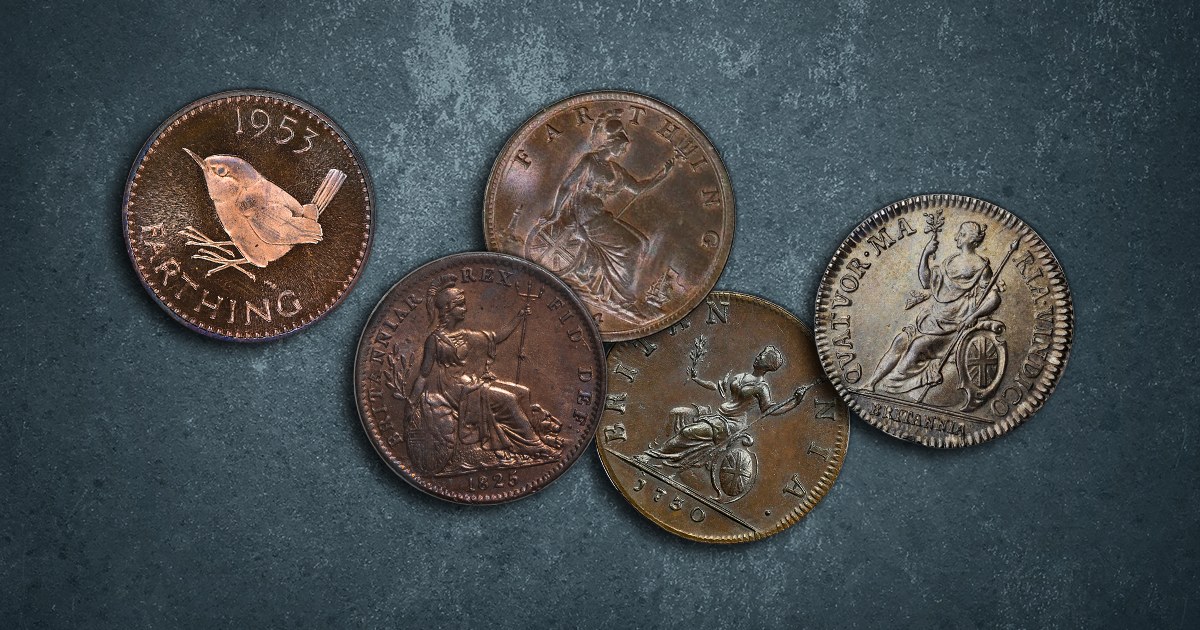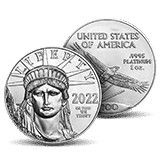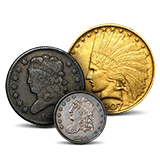
The farthing was a small British coin that played a significant role in the country’s economy for centuries. As its design evolved, it reflected shifts in British society, royal iconography, and artistic tastes.
Background of the Farthing
The word farthing comes from an Old English word fēorðing, which meant “a fourth.” Its value was one-fourth the value of an English penny, or one-half the value of a halfpenny. While it has not been issued since the 1950s, the name is still used in colloquial British phrases to indicate poverty, such as “They haven’t got two farthings to rub together.”
Early Designs of the British farthing
Earliest Farthings
The oldest known farthings are cut into quarters, a widespread practice for medieval coins. It is believed by some that a number of these were cut by those who struck the coin as a means of producing fractional coinage. The earliest of these dates to early Anglo-Saxon times in the 8th century and have been found throughout England.
Edward I (1279-1307)
The oldest known round farthings date to the reign of King Edward I. These silver issues depicted the portrait of the king on the obverse and featured a cross on the reverse. The design allowed the coin to be split into smaller denominations, which was useful for minor transactions in medieval England. The simple cross design became an emblem of practicality, marking the earliest stages of the farthing’s history.
There were rarely enough farthings to satisfy the coinage needs of the English nation and producing the silver farthing proved too great a burden.
17th Century Transitions
James I (1603-1625)
Farthings were issued with the same design under Edward II, Edward III, Richard II, Henry IV, and other kings until King James I.
Under James I, the farthing underwent significant changes, transitioning from a silver to a copper composition. The copper farthings design with a crown and two scepters on the obverse symbolized the king’s authority. The reverse displayed a crowned harp, reflecting James I’s desire to unite the kingdoms of England and Scotland. Farthings of this period were subject to counterfeiting in greater numbers than silver farthings were.
Charles I (1625-1649)
Charles I continued the composition of copper farthings, maintaining similar designs to those under James I. However, variations appeared in the portrait and inscriptions, reflecting subtle shifts in royal representation. These coins embodied the monarchy’s identity during a period of political upheaval and transition.
The Introduction of Britannia
Charles II (1660-1685)
The farthing began featuring an iconic symbol under Charles II, who introduced the Britannia reverse in 1672. This farthing depicts Britannia seated and holding a trident and shield, symbolizing Britain’s naval dominance and resilience. This depiction became synonymous with British coinage, representing strength and unity, and it marked the beginning of a long-standing tradition in British numismatics. The obverse featured a left-facing bust of the King.
18th and 19th Century Evolutions
George I to George III (1714-1820)
The Britannia reverse design persisted through the reigns of George I, George II, and George III. Each monarch’s portrait was found on the obverse, while minor stylistic changes to Britannia were made on the reverse. This continuity emphasized stability and strength during the expansion and slow growth of the British Empire.
George IV (1820-1830)
During George IV’s reign, the farthing offered a more detailed and refined image of Britannia. On the obverse, the king’s portrait added a touch of sophistication, aligning with the period’s artistic sensibilities. The coin’s reflected advancements in minting techniques and the design aesthetics of the era.
Queen Victoria (1837-1901)
Under Queen Victoria, farthing designs varied significantly. Early issues featured a Young Head portrait, which depicted a youthful Victoria, and later coins displayed the Veiled Head or Old Head as the Queen aged. The reverse continued to depict Britannia, but Victoria’s changing portrait encapsulated the length of her reign, and each design marked a new chapter in her monarchy.
20th Century and The Wren
George V (1910-1936)
George V’s reign marked the final years of the Britannia reverse on the farthing. On these issues, King George V’s portrait graced the obverse and Britannia remained on the reverse. This period symbolized the last chapter of the classic Britannia farthing, as Britain faced social changes that prepared it for a new era of currency.
George VI (1936-1952)
The wren reverse design was proposed during Edward VIII’s reign but was not utilized until it was struck on farthings issued under George VI in 1937. The wren is one of Britain’s smallest birds and is seen as symbolizing modesty and charm. The new motif represented a shift from Britannia’s power to a humbler and more approachable symbol that reflected societal changes in post-war Britain.
Elizabeth II (1952-1956)
Elizabeth II’s farthings retained the wren on the reverse, while her portrait appeared on the obverse. These farthings were last struck in 1956, marking the end of the coin’s long history. By 1961, the farthing was withdrawn from circulation, and it ceased to be legal tender, ending an era of small denominations.
The British farthing’s designs, from the cross of Edward I to the wren of Elizabeth II, weave a rich tapestry of British history. Today, the farthing is a collectible piece that is cherished for its historical significance and the story it tells about Britain’s numismatic journey.




